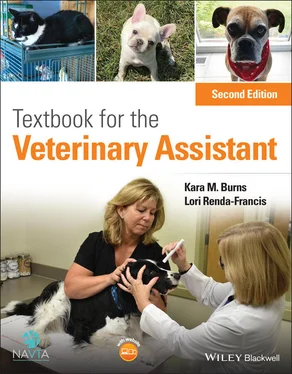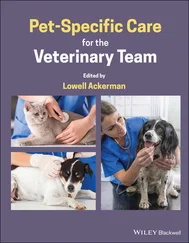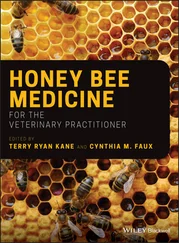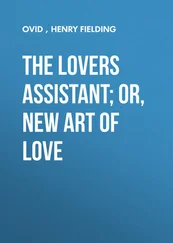Using a muzzle is another way to protect the health‐care team, the owner, and the dog if the patient is nervous or aggressive. There are a number of muzzles available and a recommendation of a type or brand should be given by the health‐care team to the owner. The muzzles most often used are a wire/Baskerville muzzle, a nylon/Mikki muzzle, or a gauze muzzle. In place of a commercially manufactured muzzle, health‐care team members can utilize a roll of gauze, a nylon sock, or even a piece of rope. However, the dog needs constant monitoring when it is muzzled to ensure there is no obstruction to the airway. Care must also be taken to ensure the muzzle can be removed efficiently and quickly. If the dog is thought to be likely to bite, its head should be safely restrained by a health‐care team member while the muzzle is removed. Muzzles should be used only short term because they prevent dogs from panting and could thus lead to overheating if left on for extended periods. The health‐care team should be especially prudent when using muzzles on brachycephalicbreeds. Typically, a gauze muzzle is to be used for brachycephalic breeds. Scissors should be close at all times in case a muzzle needs to be cut off and quickly removed.

Figure 4.1 Rope leash.
Source: Sheldon, C.C., Topel, J. and Sonsthagen, T. 2006. Animal Restraint for Veterinary Professionals . Elsevier, St Louis, MO.
Care should be taken when applying muzzles. When applying muzzles to an animal on the floor, you should never kneel or sit, instead you should squat so that you can move away quickly if needed. Ideally, a second person should be restraining the animal when a muzzle is being placed. If you must place a muzzle alone, you should carefully approach the animal and apply the muzzle from the back or side of the animal.
Application of a gauze muzzle
When applying a gauze muzzle to a dog, you will want to utilize a nonstretch gauze. Cut a large piece of gauze to ensure that you have enough to wrap around the muzzle and behind the dog’s head and still have enough to tie in a bow. It is better to have too much versus too little, since you may only have one good chance to muzzle the upset dog before someone gets injured. The dog should be in sitting or sternal or sitting recumbency.
Start by making a loop in the center of the gauze strip and cross one end under to create a half‐knot. Once the loop is made you can carefully approach the dog from the back or the side. If the dog is being restrained you can approach him from the front. Bring the open loop down in front of the dog’s muzzle and slide it on to the muzzle. Quickly tighten the gauze with the half‐knot on top of the dog’s muzzle ( Figure 4.2). Keep your hands at a safe distance at all times, pulling the tie ends of the gauze down and around underneath the dog’s muzzle and crossing them underneath the chin. Tighten the gauze again, and then bring the ends of the gauze back behind the dog’s head, cross the ends behind the dog’s ears, and tie in a bow ( Figure 4.3).
Application of a leather, nylon or basket muzzle
It is important to select a muzzle that is the correct size. You will want to make sure that the dog is able to pant but not bite. You will also want to make sure it does not bunch the skin under the eyes and is not longer than the dog’s nose length. The muzzle should end no closer than ½ inch from the eyes. Before trying to apply the muzzle, ensure that the fastener on the muzzle is adjusted to the approximate size of the dog’s head. Approach the dog from the back or side. If the animal is being restrained, you may be able to approach him from the front. Hold the side straps out while slipping the material over the dog’s nose. The longer part of the material should be under the jaw, so the straps fasten under the ears. The shorter part of the material should be on the top of the dog’s nose. Clip the ends of the fastener together behind the dog’s head and pull the straps tight against the head.

Figure 4.2 Application of gauze muzzle (1).
Source: Courtesy of Dr Lori Renda‐Francis, LVT.
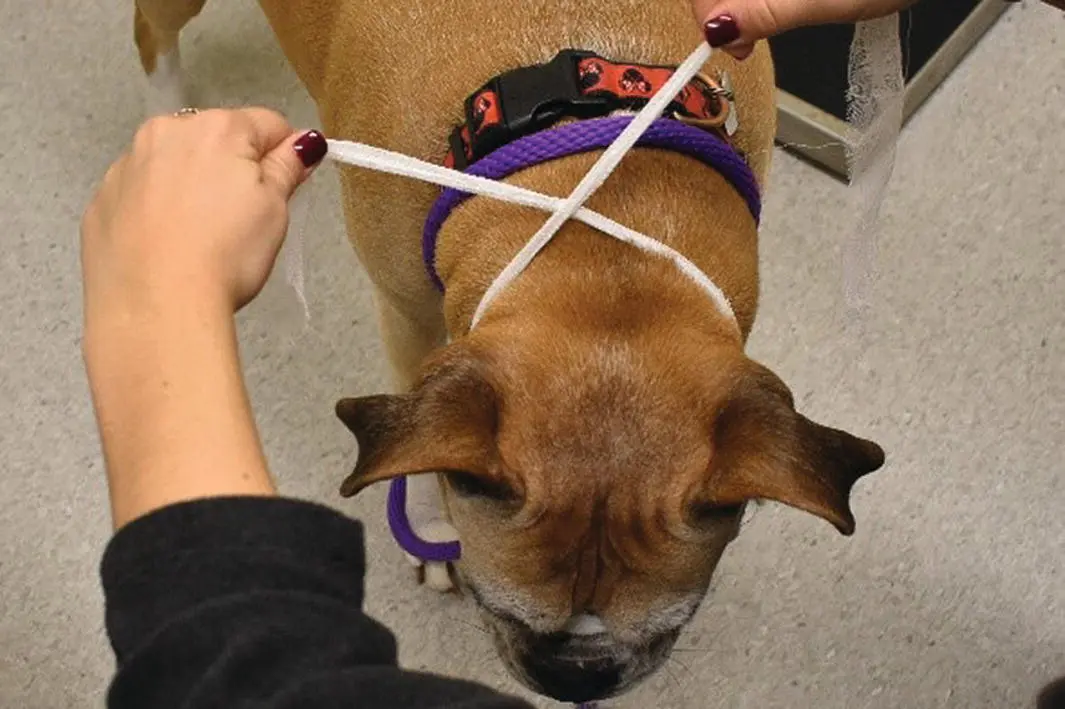
Figure 4.3 Application of gauze muzzle (2).
Source: Courtesy of Dr Lori Renda‐Francis, LVT.
A catchpole is another commercially available device that may be used to restrain and move an aggressive or fearful dog. There are many names for this device – catchpole, dog catcher, rabies pole. This is a rigid pole that allows the health‐care team member to remain at a distance from the dog while restraining it. The catchpole has a quick‐release handle, which ensures that the dog does not become strangled. Care must be taken at all times to ensure that the dog is not choking but that the loop is tight enough around the dog’s head to prevent it from slipping out. The catchpole has a loop at one end that is placed around the animal’s neck and tightened. Using this type of restraint allows for another team member to approach the animal from behind to administer medication or examine the animal.
Finally, the health‐care team member can use his or her voice to help comfort and soothe a frightened or nervous animal. It is advised to use a soft tone. For some dogs, a higher pitched voice will be soothing, and for others, a voice tone that is deep and authoritative in nature should be used. The health‐care team member should use the voice tone that makes the most sense with each dog. The use of a soft voice, regardless of the pitch, is calming to dogs. Many animals respond to a gentle serenade or shushing sound. Oftentimes, light restraint with a gentle voice is all that is needed to reassure a dog ( Figure 4.4).
All health‐care team members should be aware of the fight or flight principle when kenneling and restraining animals. If there is an opening to get out of the cage or out of a restraint hold, the animal will take it. Health‐care team members must be aware of their surroundings at all times, insuring that no route is accessible for escape by an animal prior to opening a door to remove a pet and before releasing the restraint of a pet. When taking a pet from a cage or a kennel, the health‐care team member must block the door opening with a knee or forearm to obstruct an obvious escape route.

Figure 4.4 Light restraint.
Source: Courtesy of Kara M. Burns, LVT, VTS (Nutrition).
A health‐care team member can pick up a small‐breed dog that is not fearful or aggressive by grasping the animal’s scruff or by placing a hand under the dog’s chin and placing the other hand under the thorax region. The dog’s body should be kept close to the team member’s, and a leash should be available to place around the dog’s neck. At this point the dog is secure and can be placed on the floor. Large‐breed dogs typically will be placed in a kennel or a larger cage closer to the ground. These dogs can be led out after the cage is opened, the escape route blocked, and a leash slipped around the dog’s neck.
Читать дальше
